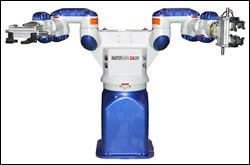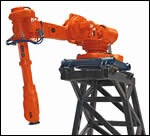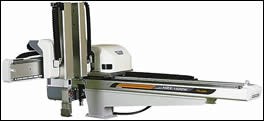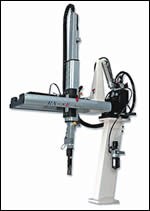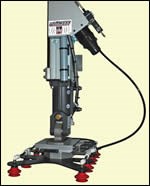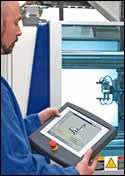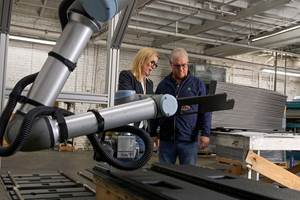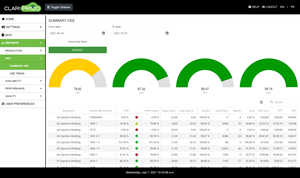NPE 2006 News Wrap-Up: Brains and Brawn - New Robots Are Handier Than Ever
Injection molding robots introduced at NPE pushed the work envelope for speed, reach, payload capacity, ease of programming, and ability to handle more sophisticated tasks.
Injection molding robots introduced at NPE pushed the work envelope for speed, reach, payload capacity, ease of programming, and ability to handle more sophisticated tasks. The news at the show included the first two-armed, 13-axis robot; the first use of RFID technology for automated tool changing; new simulation developments for off-line programming of single or multiple robots in work cells; and a new modular work-cell concept that lets users easily add or remove “plug-and-play” modules for secondary operations.
Especially notable at this year’s show was the prominence of 6-axis jointed-arm robots, high-end units that are a small but growing alternative to conventional beam robots for cell-type applications that combine press tending and post-molding operations. However, there were also numerous incremental improvements in beam robots—still the workhorses of press automation—which showed up in new sizes and with improved controls.
More axes than ever
As if six axes weren’t enough, new models at the show went a step—or several steps—further. One novel entry provides an unprecedented 13 axes of motion by combining two six-axis articulated arms on a common rotating base. The new DA20 dual-arm model was a highlight of Motoman’s exhibit at the show. Both arms can work together to double the payload capacity (44.1 lb per arm) or perform intricate tasks that require “two hands”—or they can operate independently. The robot can transfer a part from one arm to the other with no need to set the part down temporarily, and it can provide “jigless” operation where one arm holds the part while the other performs operations on it. The DA20 uses Motoman’s NX100 PC controller with Windows CE programming pendant, which has a color touchscreen display.
Motoman also rolled out a 7-axis, single-arm robot that can straighten out vertically to take up only 1 sq ft of floor space, or straighten out horizontally at a height of about 2 ft above the floor. This new IA20 robot can be mounted on the machine, floor, or ceiling and is designed to maneuver in very tight areas. It has a payload capacity of 44.1 lb and 44.9-in. reach.
Meanwhile, ABB Robotics has expanded its IRB line of 6-axis, shelf-mounted robots for machine loading/unloading with a new model aimed at medium-size and large presses. Both models have the new IRC 5 controller that allows for on-line or off-line programming. A single IRC 5 unit with ABB’s MultiMove software can control a work cell with up to four robots.
ABB’s new IRB 4450S model for medium-size injection presses handles payloads up to 66 lb and can reach more than 7 ft down or more than 3 ft below its base. The new IRB 6650S model for presses larger than 1000 tons comes in three versions with payloads of 198 to 440 lb and reach from 153 to 118 in. respectively.
Fanuc Robotics introduced the R-2000iB 6-axis robot designed for part transfer, machine loading, and other tasks. With payload capacity from 363 to 462 lb and 8.6-ft reach, it has the same work envelope, mounting interface, operation, and programming as the R-2000iA model, but its brand-new R-J3iC controller has vibration control that allows faster acceleration/deceleration without vibration, permitting cycle times to be cut about 5%. The controller also has an integrated vision function that needs no additional processing software. Also new is software that controls and coordinates up to 10 robots through exchange of position and motion data. Its simplest use is to prevent interference between the robots.
Fanuc Robotics also unveiled its M-710iC six-axis robot that sports a large work envelope and small footprint. It comes in three versions with payloads ranging from 110 to 154 lb. It also uses the new R-J3iC controller. The unit can be mounted on the floor, ceiling, or wall, and comes with a reach of 4.5 to 6.7 ft.
Staubli rolled out two new models in its TX series of low-payload 6-axis robots. The TX60 has a maximum load capacity of 19.8 lb and 2.2-ft reach. The TX60L model takes a payload of 11 lb and has 3-ft reach.
As reported in May, Kuka Robotics brought out an injection molding software package that makes it easier to integrate its six-axis robots with injection presses, thus reducing installation and engineering time.
Also as reported in May, a new firm, Actus Automation, is marketing a new approach to press-side automation from Animex of Sweden. The xFlex system uses a single 6-axis robot to demold parts and present them to a series of up to six wedge-shaped modules arranged in a semi-circle, each module devoted to a single post-mold operation. Any of a family of 25 “plug-and-play” modules can be quickly inserted or removed from the press-side cell.
All-servo traverse robots
There’s also plenty of news in the more typical 3- to 5-axis traverse robots for injection molding. Harmo robots from Japan, formerly available from Conair, are now supplied in North America exclusively by AEC and sister company Sterling. They exhibited Harmo’s new line of HRX full-servo models for presses from 40 to 1000 tons. They come with one or two arms (for separate removal of parts and runners) and one-stage or two-stage telescoping vertical arms. Two-stage arms are standard for the HRX 300 model and larger. Features include a rigid kick frame and a thick-walled, extruded-aluminum traverse base with a ridged steel sub-weldment to suppress vibration and resist deflection during critical operations. An ultra-thin wrist-flip unit reduces mold-open stroke and can be flipped on the fly to pick from either mold half. HRX models are offered with an F controller.
Automated Assemblies added a large model to its Raptor line of top-entry servo robots designed for three-plate and stack molds in presses from 200 to 800 tons. The Raptor 3000-HP has a horizontal reach up to 59 in. and vertical stroke up to 55 in. Payload capacity is 22 lb per vertical arm. It comes with InteliMotion control and carbon-fiber vertical arm and EOAT.
Conair introduced its Sepro Axess series of 3-axis all-servo beam robots designed for pick and place applications on molding machines up to 650 tons. Its Axess 10, 20, and 30 provide horizontal strokes from 60 to 80 in., stripping strokes from 14 to 33.5 in., and speeds up to 6.5 ft/sec. Vertical strokes range from 40 to 55 in. with vertical speeds up to 9 ft/sec. Telescoping vertical arms for low-ceiling operations are offered with the Axess 20 and 30. Payload capacities are 7.7 to 26.4 lb. The Axess control has an icon-driven touchscreen and storage for 99 molds. Users can create a program from scratch or build a sequence from stored templates. A PC link allows off-line programming.
Conair also brought out the newest and biggest model in the Sepro Generation IV 4000 Series. The new Sepro 4050 is suited to presses up to 2500 tons and comes standard with 118-in. horizontal stroke, 94-in. vertical stroke, and 51-in. strip stroke, plus payload capacity up to 77 lb. The “extended” option provides vertical stroke of 102 in., strip stroke of 59 in., and payload capacity of 121 lb. A new servo wrist can rotate 180° or 270°. Digital control software features a novel function that allows users to electronically fine-tune and store the vacuum settings for a job. Conair says this is a first. Previously, robot users had to climb up to adjust settings mechanically on the robot arm.
Engel introduced its new ERS Speedy series to the U.S. The all-servo high-speed robot is designed to handle thin-wall parts in press cycles less than 5 sec. Minimum demold time is 0.3 sec, and linear speeds are up to 8 meter/sec. The robot’s RC100 or RC200 control can be integrated in the Engel’s CC100 or new CC200 machine controllers.
HYRobotics may be a new name to many North American molders. This Korean firm—reportedly the first in that country to produce a full-servo robot—has a U.S. office. At NPE, HYRobotics showed its new Nexia series of full-servo traverse robots, which come in 20 models suited to presses from 100 to 4000 tons. They can be used in insert/over-molding applications and are offered with three to seven axes of motion with a servo wrist. The touchscreen control comes with modules for stacking, insert, and inspection operations, with a camera module optional.
HYRobotics also introduced its SKY series 4-axis pneumatic traverse robots for presses from 50 to 250 tons. Controls are adapted from its new TOP IV line of sprue pickers. SPI interface and SPI mounting-hole pattern are standard.
A new automation system from HYRobotics uses pneumatic tubing to blow thin-walled inserts from a feeder bowl onto a fixture, from which the inserts are picked up by a traversing robot and delivered to the mold. Used in molding cell phones and PDAs, this “Hose Shooting Insert Unit” is said to be a lower-cost alternative to using a SCARA robot to pick and place the inserts onto the fixture for pickup by the traversing robot, and programming is eliminated.
Ilsemann’s newest entry is “Fred,” a 3-axis servo robot for high-speed applications. It has a three-stage telescoping vertical arm and reportedly achieves speeds of about 3000 mm/sec on its main axes.
Krauss-Maffei introduced its LR series of 3-axis servo robots to the U.S. market. Five models have payload capacities from 22 to 220 lb. They can be controlled either from the K-M press control panel or with a stand-alone control with handheld pendant for use with older K-M machines or other press brands. Off-line-programming is available in both cases. K-M plans to offer a handheld pendant even to users of new K-M presses, giving them a choice of programming the robot through the machine panel or the pendant.
Sailor Automation brought out the RZ-VE line of full-servo 3-axis robots that uses a ball-screw mechanism to deliver precise and accurate movements. New vibration-suppression control aids extraction of heavy payloads at high speeds and precise movements at the unloading or palletizing position with accuracy to 0.1 mm. Programming is said to be simpler and faster than ever.
Star Automation showed off a new line of 3- or 5-axis servo traverse robots for presses from 80 to 800 tons. For example, the 800V model is suited to presses from 80 to 300 tons and has 33.5-in. vertical stroke and 63-in. traverse stroke, plus a payload capacity of 11 lb. The larger 1200V model comes with a 51.2-in. vertical stroke and 78.7-in. traverse stroke. Payload capacity is 33 lb.
The new W 723 CS3 robot from Wittmann has three servo axes and a telescoping vertical arm. Suited to machines up to 275 tons, it has a 47.2-in. vertical stroke, payload capacity of 11 lb, and freely programmable CNC 6.2 controller.
Wittmann also developed a new robot specifically for stack and three-plate molds. Model W 746 is designed for presses from 400 to 1000 tons and features five servo drives and two arms with telescoping vertical axes and strokes up to 2000 mm. Horizontal stroke can go up to 4000 mm, and the fixed kick-axis frame can reach up to 1500 mm. Each arm has a payload capacity of 55 lb. The two vertical arms can be programmed individually. The robot also comes in a “D” configuration with two identical vertical arms that have pneumatic wrist flip for placing parts flat on conveyors or auxiliary equipment for secondary operations. The CNC 6.2 control cabinet is integrated behind the horizontal axis to save floor space.
Yushin added the RAII alpha 1300 HS model to its Webliner top-entry series. It is designed to extract large parts from presses of 1100 to 1760 tons in as little as 1.3 sec. It handles payloads up to 55 lb with servo drive on the three main axes, while the wrist flip is pneumatic. It comes with a two-stage telescoping arm. Take-out dry cycle takes 0.55 sec and overall cycle time is 3.51 sec.
Yushin also introduced a low-cost robot series with its E-touch compact controller. The YA/YAII series has an operator interface similar to Yushin’s RA/RA III series. Yushin also redesigned its FLX teaching software with ability to program off-line its RA/RAII and YA/YA II series robots and sprue pickers. Once a program is created, users can run a simulation to verify the operating sequence of the robot with the molding machine and the robot’s cycle time (for servo robots only).
Speedy side-entry models
Ilsemann has a new servo-driven, high-speed, side-entry robot for machines up to 165 tons running cycle times under 2.5 sec. Model SMB 122 SHI reportedly can be used with mold-open times less than 0.3 sec. Its double-jointed arm is constructed of cast aluminum for lightness plus rigidity. It has a 1600-mm maximum takeout stroke, but its compact design permits operation inside the molding machine’s guarding. Payload capacity is 2.2 lb.
As reported in May, Yushin came out with an usual servo side-entry robot that also performs post-mold part stacking operations. The SXA-300 V has a payload capacity of 17.6 lb, and it also has a vertical stroke (unlike most side-entry models) of 325 mm to allow it to place parts on a conveyor or stacker. It comes with three or five axes and handles both the runner and product in a takeout time of 0.63 sec.
Yushin has also rolled out a new two-axis side-entry servo robot for parts removal from vertical injection machines up to 150 tons and insert molding with vertical machines up to 50 tons (EOAT is heavier for insert loading). The new SVR-B50 with color touchscreen control has a two-stage telescoping arm that can place inserts and extract parts within a 1.58-sec dry cycle.
Pickers progress
Conair rolled out its new MXS sprue pickers that feature servo drive on the kick stroke. This feature allows kick-stroke position settings to be changed digitally and remotely, and the settings can be stored and recalled whenever a mold is changed. A handheld pendant with freely programmable controls also allows users to choose from 20 factory-set sequences for robot programming or create customized motions. The series comes in five models for machines from 20 to 550 tons. The robots handle payloads from 1.1 to 4.4 lb and offer takeout times as low as 0.6 sec with overall cycle times as short as 3 sec. The picker pivots out of the way for mold changes.
HYRobotics rolled out its new TOP IV series of swing-type sprue and parts pickers. Suited to vertical or horizontal presses from 30 to 500 tons, they deliver 0.7-sec takeout time. Its handheld controller has an LCD graphic display and a magnetic backplate for easy mounting. The machine interface box is attached to the robot body to minimize its footprint. A non-contact proximity sensor is standard.
Sailor’s new RX-8E swing-type sprue picker is said to be the first to feature THK linear guides that deliver more rigid and precise vertical arm movements. Four models fit injection presses from 120 to 350 tons. Main arm vertical stroke is from 23.6 to 35.4 in., and maximum stripping reach is 19.7 in. Payload capacity is 11 lb.
Wittmann’s new W 702 series sprue pickers feature vibration-absorbing air cushions on the kick stroke and a pneumatic shock absorber on the vertical axis. Also, a new spring-loaded indexing pin aids fast and precise repositioning of the picker after a mold change. The gripper finger can be swiveled 5° to get a better grip on sprues. The new SA7 controller has four standard program sequences for simple setup and also permits user development and storage of 25 custom programs.
Yushin updated its HOP-Five series of 3-axis pneumatic sprue pickers with fewer parts for greater rigidity, and higher speed. It has the new GII controller with lead-through teach programming. Yushin will add a new 650 model to its current 550 and 750 series pickers.
New approaches in controls
Wittmann has introduced radio-frequency identification (RFID) technology on its robots to enable them to recognize the EOAT selected during an automatic tool change and to retrieve the correct program from the robot controller. The EOAT recognition system is supported by Wittmann’s R7 robot control. The control communicates with an RFID transponder placed on the tooling. A reader and antenna mounted on the vertical axis of the robot detect tool changes automatically. The robot program can be stored together with mold data and a photo of the part to be produced.
Logic One released its new “SIMPLE” (Sequential Inverter-Induction Motor Plain-Logic Electric) family of retrofit controls for standard 3-axis injection molding robots. Logic One will retrofit older pneumatic or electric robots with electric induction motors, frequency drives, and Allen-Bradley PLCs. Based on off-the-shelf components, the controls are designed for small to mid-sized molders who don’t have in-house automation engineers. Three controller types offer position repeatability ranging from ±1 mm to ±3 mm. Maximum speeds for robot motions are 1.5 to 3 meters/sec.
Virtual robots
Although a few suppliers of beam robots supply simulation software to assist in off-line programming of work cells, simulation is more widely available from makers of 6-axis articulated-arm robots. At NPE, ABB showed upgrades to its RobotStudio5 3D software, such as a new Path Optimization feature that helps program the most efficient robot motions and warns about potential collisions.
A new AutoReach feature automatically analyzes the reach of the virtual robot and helps the user ensure that all intended workcell positions are actually reachable by the robot. Also new is a MultiMove function that runs several virtual robot programs at the same time. For secondary operations, a new time-saving AutoPath feature automatically generates robot positions based on a CAD model of the part to be handled.
Fanuc Robotics and Motoman also announced upgrades to simulation software aimed at speeding up programming of secondary operations, such as trimming/routing (see p. 32).
Related Content
Cobot Creates 'Cell Manufacturing Dream' for Thermoformer
Kal Plastics deploys Universal Robot trimming cobot for a fraction of the cost and lead time of a CNC machine, cuts trimming time nearly in half and reduces late shipments to under 1% — all while improving employee safety and growth opportunities.
Read MoreScaling New Heights With Vertical Integration
Eden Manufacturing was founded on a vision of vertical integration, adding advanced injection molding capabilities to a base of precision moldmaking and more recently bringing Swiss-type machining capabilities in-house.
Read MoreAI: The Next Big Thing in Plastics Processing
Discover how artifical intelligence is revolutionizing plastics processing. Hear from industry experts on the future impact of AI on your operations and envision a fully interconnected plant.
Read MoreReal-Time Production Monitoring as Automation
As an injection molder, Windmill Plastics sought an economical production monitoring system that could help it keep tabs on its shop floor. It’s now selling the “very focused” digital supervisor it created, automating many formerly manual tasks.
Read MoreRead Next
Making the Circular Economy a Reality
Driven by brand owner demands and new worldwide legislation, the entire supply chain is working toward the shift to circularity, with some evidence the circular economy has already begun.
Read MoreBeyond Prototypes: 8 Ways the Plastics Industry Is Using 3D Printing
Plastics processors are finding applications for 3D printing around the plant and across the supply chain. Here are 8 examples to look for at NPE2024.
Read More


